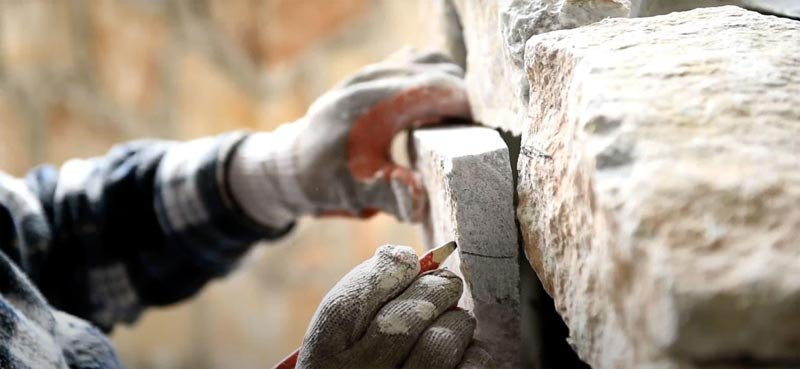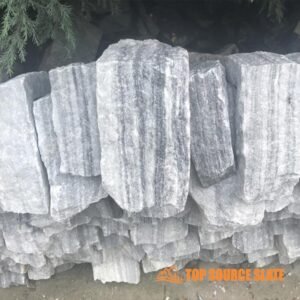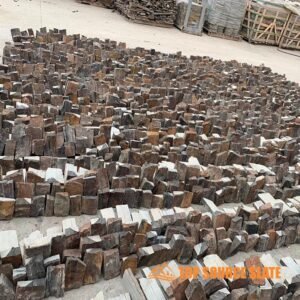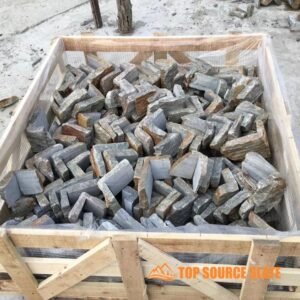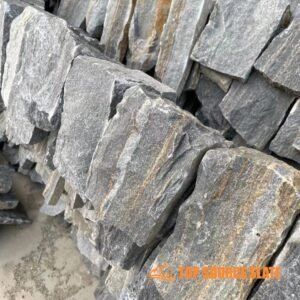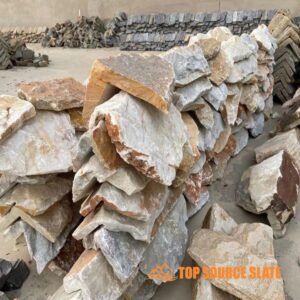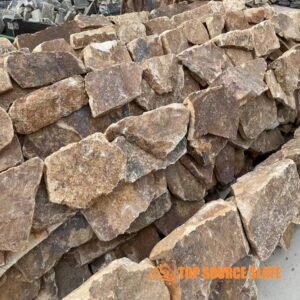建物a ドライスタックの石の壁 職人技と機能設計をブレンドするプロジェクトです。このタイプの壁はモルタルなしで構築され、石の正確な配置に依存して頑丈な構造を作成します。このガイドでは、プロセスを段階的に説明します。重要な詳細を組み込んで、壁が耐久性があり、視覚的に魅力的であることを確認します。
計画と準備
ドライスタックストーンウォールプロジェクトを成功させるには、適切な計画が重要です。壁の総面積を計算することから始めます。地形の斜面や不規則性を考慮して、長さと高さを測定します。これらの測定は、必要な石の量やその他の材料を推定するのに役立ちます。
材料とツール
いくつかのツールと素材が必要です。
- ツール:シャベル、ロックハンマー、小さなスレッジハンマー、チゼル、ストリングライン、レベル、手袋、安全ゴーグル、こて、ゴム製マレット、およびモルタルパドルでのミキシングドリル
- 材料:ドライスタックの石、基礎と埋め戻し用の砂利、穴あき排水管(必要に応じて)、追加の安定性が必要な場合は修正されたモルタルまたは接着剤
ドライスタックストーンの選択
積み上げやすいように、上下が平らな乾いた積み石を選択してください。塊状の石、または形状がより均一な石は、建築プロセスをスピードアップします。不規則な石を使用すると、より素朴な外観を得ることができますが、適切に組み合わせるにはより多くのスキルと時間が必要です。
-
 卸売黒色珪岩ドライスタックランダムクラッディング
卸売黒色珪岩ドライスタックランダムクラッディング -
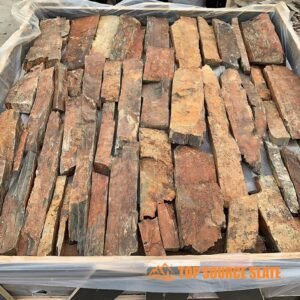 最高品質の乾式スタック石壁クラッディング
最高品質の乾式スタック石壁クラッディング -
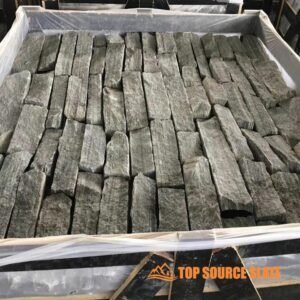 工場直販の安いルースストーンウォールクラッディング
工場直販の安いルースストーンウォールクラッディング -
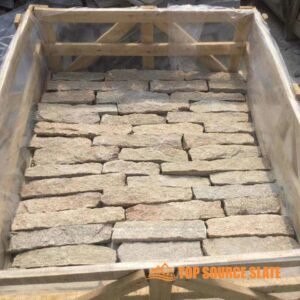 工場直送のランダムな天然石の壁のクラッディング
工場直送のランダムな天然石の壁のクラッディング -
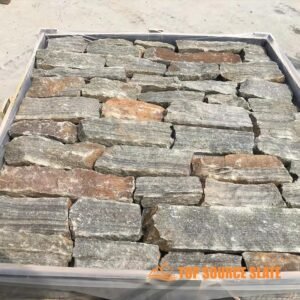 屋外装飾ルースドライスタックレッジ石クラッディング
屋外装飾ルースドライスタックレッジ石クラッディング -
 中国サプライヤー不規則な壁被覆石ベニヤ
中国サプライヤー不規則な壁被覆石ベニヤ -
 中国メーカーの外装天然ルースストーンウォールクラッディング
中国メーカーの外装天然ルースストーンウォールクラッディング -
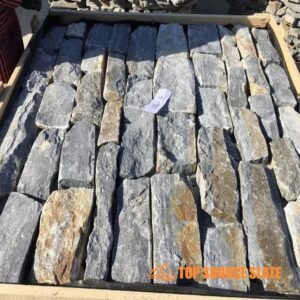 中国メーカールースレッジストーン天然石ベニヤ
中国メーカールースレッジストーン天然石ベニヤ -
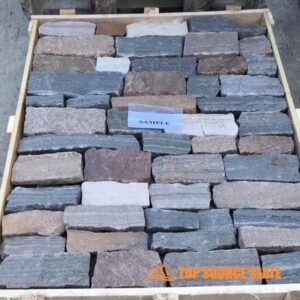 中国ベンダーの屋外乾式スタック石造りの暖炉
中国ベンダーの屋外乾式スタック石造りの暖炉 -
 中国の輸出業者は、乾燥した積み重ね石を緩めます
中国の輸出業者は、乾燥した積み重ね石を緩めます -
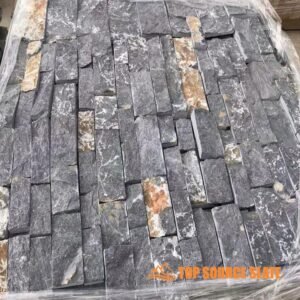 中国の卸売ドライスタックストーンハウスエクステリア
中国の卸売ドライスタックストーンハウスエクステリア -
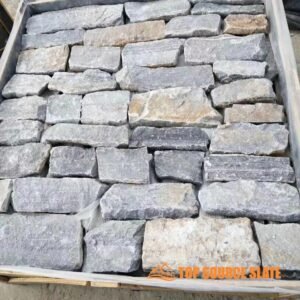 中国卸売乾式積み重ね天然石ベニヤ
中国卸売乾式積み重ね天然石ベニヤ -
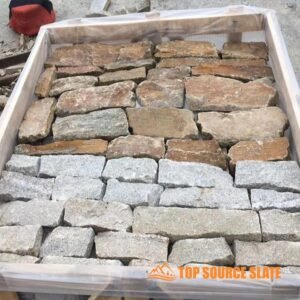 中国メーカーの乾燥スタックストーンクラッディング
中国メーカーの乾燥スタックストーンクラッディング -
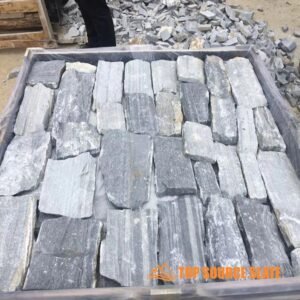 内部および外部ドライスタックストーンタイル
内部および外部ドライスタックストーンタイル -
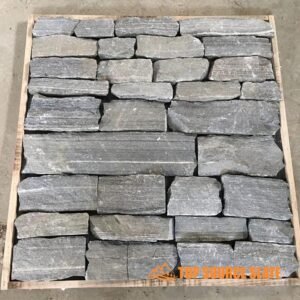 壁の覆い用の内部と外部の緑のゆるい石
壁の覆い用の内部と外部の緑のゆるい石 -
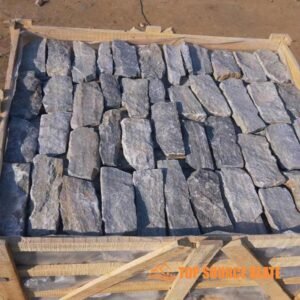 自然なルースストーンを特徴とする壁被覆ストリップ
自然なルースストーンを特徴とする壁被覆ストリップ
基礎の準備
基礎はあなたの人生の最も重要な部分です ドライスタックの石の壁。まず、壁の長さに沿って深さ約 4 ~ 8 インチの溝を掘ります。トレンチは、最大の石を収容できる十分な幅を持つ必要があります。溝を圧縮した砂利で満たします。これは安定した基礎として機能し、排水を助けます。
排水に関する考慮事項
壁が大雨や排水不良になりやすい場所にある場合は、排水システムを設置することが不可欠です。穴の開いた排水管を根元に置き、濾布で包み、さらに砂利をかぶせます。この設定により、水を壁から遠ざけ、浸食や不安定のリスクを軽減します。
最初のコースの敷設
乾式積み石化粧板の最初のコースは、壁全体が構築される基礎です。最大で最も平らな石を、圧縮された砂利のベースに直接置きます。壁全体の安定性はこの最初の層に依存するため、各石が水平で、所定の位置にしっかりと固定されていることを確認してください。
接着剤やモルタルを使用する場合
特に高い壁や厳しい気象条件にさらされている壁で安定性を高めるには、改良モルタルまたは接着剤の使用を検討してください。ギザギザのこてでモルタルを広げ、各石の下に完全なベッドを作り、乾いた積み石壁の外観を維持しながら、石を所定の位置に固定します。
石を積み上げる
積み上げ段階では、乾式積み石壁を構築する真の芸術性が発揮されます。安定性、適切なフィット感、見た目の美しさを確保するために、各石を慎重に選択し、形を整え、配置する必要があります。このステップでは、最初のコースから壁の頂上まで進みながらテクニックを磨きます。以下の詳細なガイドラインに従って、適切に構築され、視覚的に統一された壁を確保してください。
安定性を高めるためのドライスタックストーンの配置
石を積むときは安定性を優先することが大切です。常に各石がその下の石の上にしっかりと固定されるように配置します。新しい石ごとに、次のテクニックを使用します。
- 配置のために小刻みに動く: 各石を配置した後、それが下の石にしっかりと落ち着くように、軽く小刻みに動かします。これにより、モルタルを使用しない場合でも、エアギャップがなくなり、より安全な接合が形成されます。
- 試験の安定性:各石の動きを確認してください。ぐらつく場合は、位置を変えるか、下の石を調整してより安定したベースを作成してください。小さな石をシムとして使用して、大きな石の下の隙間を埋めることもできます。
関節を壊す
石を積むときの重要な原則の 1 つは、あるコースから次のコースへ垂直方向の継ぎ目を並べないようにすることです。として知られるこのテクニックは、 “関節を壊し、” 壁の安定性と強度を高めます。その方法は次のとおりです。
- 各石をオフセットする: 各石は、その直下の乾積み石の間の接合部に重なる必要があります。この方法により、壁全体に荷重がより均等に分散され、弱い部分の形成が防止されます。
- さまざまな石のサイズ:大小のストーンを組み合わせて好みのオフセットパターンを実現します。大きな石は安定させるアンカーとして機能し、小さな石は隙間を埋めてより複雑なデザインを作成します。
壁を後ろに傾ける(バッター)
乾式積み石壁の構造的完全性を高めるには、石壁を堤防または丘の中腹にわずかに傾けます。 “打者。” これは擁壁にとって特に重要です。
- リーンの角度: 高さ 1 フィートごとに、壁は堤防に対して約 2 インチ後ろに傾く必要があります。この傾きは壁の後ろの土からの圧力に対抗し、壁が前方に倒れるのを防ぎます。
- 一貫性: 建設中に壁の打面を定期的にチェックするには、ストリングラインと水準器を使用します。これにより、一貫した傾きが保証され、不安定につながる可能性のある壁の部分が過度に垂直になるのを防ぎます。
強化用デッドマンストーン
壁の強度をさらに高めるために、定期的に挿入してください “死人” 石。これらは壁の表面から背後の堤防まで伸びる長い石です。
- デッドマンストーンの配置:数フィートごとに、壁の後ろの地面に深くまで伸びる長い石を置きます。これらの石はアンカーとして機能し、壁を堤防に結び付け、壁の重量を分散するのに役立ちます。
- 頻度: 壁のサイズに応じて、水平方向と垂直方向に 3 ~ 5 フィートごとにデッドマン ストーンを配置します。これらの石は、より高い壁や大量の土を保持する壁にとって非常に重要です。
ドライスタックストーンを整形してぴったりとフィット
石を積み重ねるときに、よりぴったりとフィットするように形を整える必要がある場合があります。目標は、隙間をできるだけ少なく、滑らかで連動する壁面を作成することです。
- ノミとハンマーの使用: ドライスタックストーンが完全にフィットしない場合は、ロックハンマーとノミを使用して余分な材料を削り取ります。石が割れないように、小さな破片を一度に取り除きます。
- ギャップを埋める: 大きな石の間の隙間を埋めるには、小さな石または石チップを使用します。これにより、構造が強化されるだけでなく、壁の美的魅力も高まります。
埋め戻しの層化
壁を構築するときは、定期的に砂利を埋め戻すことが重要です。埋め戻しには、壁の追加のサポートの提供や排水の改善など、複数の目的があります。
- 数コースごとに埋め戻す: 乾いた積み石を数コース敷いた後、壁の後ろに砂利の層を追加します。砂利は石の後ろに数インチ伸ばして、サポートを提供するために圧縮する必要があります。
- 排水機能: 砂利は、水が壁の後ろに溜まるのではなく、壁を通して排水するのにも役立ちます。水が圧力を高めて壁が傾いたり、崩壊したりする可能性があります。
不規則な石への対処
不規則な石を使用している場合は、より戦略的に配置する必要があります。目的は、美しさと安定性のバランスを達成することです。
- ランダムなパターンで自然な外観を実現: 乾いた石を積み上げ、途切れることのない水平または垂直の線が長くならないように配置します。これにより、壁の強度を維持しながら、より自然な外観が得られます。
- サイズと形状の混合: さまざまなサイズと形状の石を使用して、視覚的な興味を生み出し、大規模な切断の必要性を減らします。大きな石は壁を固定することができ、小さな石は隙間を埋めてテクスチャを追加します。
一定の高さを維持する
積み重ねるときは、定期的にひもや水平器を使って壁の高さを確認してください。各コースのレベルを維持することで、壁が視覚的に魅力的で構造的に健全であることが保証されます。
- 正確性を高めるストリングライン: 各コースの希望の高さで壁の長さに沿ってストリングラインを引きます。これをガイドとして使用して、乾燥した積み石が均等に配置されていることを確認します。
- シムによる調整: 石の位置が低すぎる場合は、より小さい石またはシムを下に使用して、正しい高さまで上げます。
トップコースを完走する
キャップストーンとして知られる最後の石のコースは、完成した外観とさらなる安定性の両方を提供します。トップコースには、すべてを所定の位置に固定するために、より大きくて平らな石を選択してください。
- キャップストーンの配置: キャップストーンをしっかりとセットし、平らでしっかりとフィットしていることを確認します。これは壁を結合するのに役立ち、乾燥した積み石が時間の経過とともに移動するのを防ぎます。
- キャップストーン用のオプションのモルタル: 壁の残りの部分は乾式積みですが、特に壁が人の往来や天候にさらされている場合は、安全性を高めるためにキャップストーンをモルタルで塗ることを選択できます。
これらの手順に注意深く従うことで、乾式積み石壁が美しく耐久性があり、時の試練に耐え、景観に時代を超越した魅力を加えることができます。
関連:
取り扱いコーナー・特集
コーナーを処理し、窓、ユーティリティ ボックス、照明器具などの特殊な機能を組み込むことは、乾式積み石壁を構築する上で重要な要素です。コーナーには、壁の構造的完全性と美的魅力を維持するために、正確な計画と慎重な石の配置が必要です。同様に、特別な機能に対処するには、壁とのシームレスな統合を確保するための創造性と精度が必要です。これらの課題に効果的に対処する方法を次に示します。
建物のコーナー
乾いて積み上げられた石の隅は壁の構造の重要な部分です。角の構造が不十分だと壁全体の安定性が損なわれる可能性があるため、慎重に角に近づくことが重要です。
コーナーから始める
- 基礎が第一: 壁の残りの部分と同じように、コーナーにしっかりとした基礎を確立することから始めます。石の最初の層が水平でしっかりと固定されていることを確認します。コーナーの安定性は、基礎石がどの程度適切に配置されているかによって決まります。
- L字型の石: 可能であれば、乾式スタック壁用に特別に設計された L 字型の隅石を使用してください。これらの石は角を包み込み、2 つの交差する壁の間にシームレスで強力な接続を提供します。
- 交互コース: コーナーに石を置く場合、重なりの方向をコースごとに交互に配置してください。たとえば、あるコースでは左の壁の石がコーナーに重なり、次のコースでは右の壁の石が重なるようにします。 「ボンディング」と呼ばれるこの交互のパターンは、石をかみ合わせてコーナーの強度を高めます。
構造的完全性の維持
- 垂直ジョイントを避ける: 壁の残りの部分と同様に、乾式積み石のコーナーで垂直ジョイントを互いに直接重ねて並べることは避けてください。各コースのジョイントをオフセットさせることで、より安定した連動構造を実現。
- 大きめの石を使用する: 可能な限り、コーナーには大きな石を使用します。これらの石はより安定しており、壁の残りの部分に強力な固定点を提供します。
- レベルの確認: 壁を構築するときは、角が水平方向と垂直方向の両方で水平に保たれていることを定期的に確認してください。精度を確保するためにストリングラインまたは水準器を使用し、必要に応じて石を調整します。
特別な機能を組み込む
窓、ドア、ユーティリティ ボックス、照明器具などの特別な機能により、プロジェクトはさらに複雑になります。これらの要素を壁に適切に組み込むには、慎重な計画と正確な切断が必要です。
窓とドア
- オープニングの構成: 窓やドアの周りに建物を建てる場合は、まず開口部を石で囲みます。安定したフレームを提供するために、できるだけ大きなドライスタックストーンを使用してください。これらの石は開口部の上の壁の荷重に耐えます。
- 石に合わせてカットする: 窓やドアの周囲のスペースを慎重に測定します。石をカットしてフレームにぴったりとフィットさせ、構造を弱める可能性のある隙間が残らないようにします。正確な切断を実現するには、石材用のこぎりまたはアングル グラインダーを使用します。
- まぐさ: 開口部の上の石を支えるために、石のまぐさ (窓またはドアの上部に置かれる水平な石) の使用を検討してください。荷重を効果的に分散させるために、まぐさは各側の開口部を少なくとも 6 インチ超えて延長する必要があります。
ユーティリティボックスと照明器具
- 測定とマーキング: ユーティリティ ボックス、照明器具、またはそれらを囲む乾積み石上のその他の障害物の位置を正確に測定し、マークします。これらの機能を壁にシームレスにフィットさせるには、精度が重要です。
- 開口部の切断: アングル グラインダーまたは石材用のこぎりを使用して、これらの機能のために石に開口部を切ります。多くの場合、一度に大きな部分を取り除こうとするよりも、いくつかの小さな切り込みを入れるほうが簡単です。このアプローチは、石のひび割れや破損を防ぐのに役立ちます。
- タイトフィット: 周囲の石が正確にフィットしていることを確認します。この慎重な取り付けにより、ユーティリティ ボックスや備品が壁にしっかりと埋め込まれ、全体的な外観が統一感のあるプロフェッショナルな状態に保たれます。
排水管の設置 (必要な場合)
雨量の多い地域の擁壁や壁の場合、適切な排水が重要です。最初の数コースの石を敷いた後、濾布を巻いた排水管を壁の後ろに設置します。このパイプは、水を壁から排出できるようにわずかに傾斜する必要があります。パイプを排水石で覆い、通常どおり壁の構築を続けます。
壁に蓋をする
キャップストーンは、乾式積み石壁の仕上げです。これは機能性と美観の両方の目的を果たし、下の石を所定の位置に固定し、壁に洗練された外観を与えます。少し大きめの石や対照的な色の石を選んで、個性的な外観にしましょう。レベルまたはストリングラインを使用して、キャップストーンが均一で位置が揃っていることを確認します。
設置後: シーリングとメンテナンス
壁が完成したら、特に外壁の場合は、石をシーリングすることを検討してください。シーリングは石を湿気、汚れ、白華から保護します。メーカーの指示に従って、高品質の浸透シーラーを塗布します。シールストーンはメンテナンスが簡単で、シーラーは汚れを防ぐのに役立ちます。
継続的なメンテナンス
乾式積み石壁を長持ちさせるには、定期的なメンテナンスが重要です。壁に沈下や石のずれの兆候がないか定期的に検査し、必要に応じて調整を行ってください。外壁の場合は、時々水と柔らかいブラシで掃除すると、外観を維持できます。石を損傷する可能性があるため、強力な化学薬品や高圧洗浄の使用は避けてください。
さまざまな基材に対する特別な考慮事項
開いたスタッド壁への設置: オープンスタッド壁にドライスタック石材ベニヤを取り付ける場合、フレームワークが構造的に健全であり、石材の重量を支えることができることを確認してください。少なくとも 1/2 インチの厚さのセメントボード、または木枠、金属ラス、スクラッチ コートを組み合わせたものを使用します。
コンクリート、ブロック、レンガの上に設置する場合: 表面が清潔で、異物が付着していないことを確認してください。これには、サンドブラストまたはウォーターブラストが必要になる場合があります。表面が不均一な場合は、石を敷く前に不均一性を平らにするために厚いベッドモルタル混合物を塗布します。
スチール上に設置する: 表面の錆、汚れ、油などの汚れを取り除きます。可能であれば、厚いベッドモルタル混合物を塗布する前に、ワイヤーラスを鋼材に仮付け溶接してください。あるいは、エポキシベースの接着剤を使用して、石を清潔なスチール基板に直接接着することもできます。
結論
建物a ドライスタックの石の壁 は芸術性とエンジニアリングを組み合わせたやりがいのあるプロジェクトです。これらの詳細な手順に従い、現場の特定の要件を考慮することで、美しく耐久性のある壁を作成できます。居心地の良い暖炉用の屋内乾式積み重ね石壁を建設する場合でも、屋外の乾式積み重ね石庭壁を建設する場合でも、このガイドは、時の試練に耐える専門的な結果を達成するのに役立ちます。
トップソーススレート これらすべての領域で優れているため、家の外で覆われているか屋内の特徴的な壁に取り組んでいるかどうかにかかわらず、私たちはあなたの石のクラッディングの願いの中で最高の共犯者になります。 今日お問い合わせください 次の課題をどのように支援するかについて詳しく知るため。

